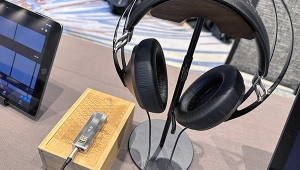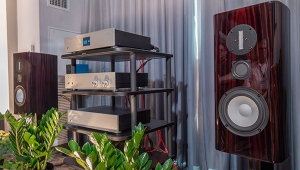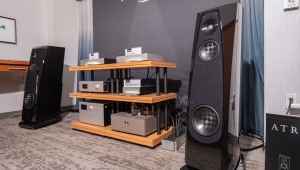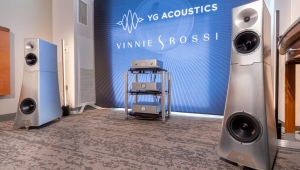| Columns Retired Columns & Blogs |
Mirage MRM-1 loudspeaker Page 2
Sound
After the mellow-balanced Acoustic Energy speakers that I reviewed in the May Stereophile, my first impression of the MRM-1s was that they had considerably more top-octave energy---not brightness as such, but more high-frequency air. The downside was that analog tape hiss was emphasized, and there was some occasional extra sizzle on cymbals. I experimented with less toe-in, but ultimately felt that this took away some of the image focus. However, if the extreme highs are lifted, they still sound very clean.
After the mellow-balanced Acoustic Energy speakers that I reviewed in the May Stereophile, my first impression of the MRM-1s was that they had considerably more top-octave energy---not brightness as such, but more high-frequency air. The downside was that analog tape hiss was emphasized, and there was some occasional extra sizzle on cymbals. I experimented with less toe-in, but ultimately felt that this took away some of the image focus. However, if the extreme highs are lifted, they still sound very clean.
At the other end of the frequency spectrum, the MRM-1 was surprisingly big-bottomed. Despite its small size, the speaker made an impressive effort at reproducing orchestral fundamentals. On my 1984 Ely Cathedral recording of Elgar's Dream of Gerontius (excerpted on Stereophile's Test CD 2, STPH004-2), the composer uses the organ to swell the orchestral scoring at climaxes. The Mirages didn't hold back from giving good measure to the organ pedals. And well-recorded jazz double bass had a fat, rounded quality to it that was very appealing. The warble tones on Stereophile's Test CD 3 (STPH006-2) were reproduced down to 50Hz without audible doubling, and even the 32Hz tone was usefully high in level (with a little help from my room). The 25Hz and 20Hz tones were missing in action, of course, with high excursions apparent from the now unloaded woofer cone.
But with its woofer having a radiating diameter of just 4", the speaker is definitely having to work hard in the bass, and the inevitable tradeoff is LF definition. Back in 1997, during the sessions for Rhapsody (Stereophile STPH010-2), I recorded my brother-in-law, Steven Stoner, playing drums at 24-bits/96kHz. I used distant mikes to capture a solid image of his Remo drumkit in the Albuquerque church. The downside of this mike technique is that the kick drum sounds intrinsically rather indistinct. Not only did his high-level kick drum pounding result in high-velocity air pulsing from the MRM-1's port---fortunately without audible chuffing---but Steve's fragile kick-drum image lost some of its leading-edge definition. While it did not sound particularly one-notey, the Mirage's low-frequency tuning did sacrifice speed for weight and extension. This balance between what are too often mutually exclusive properties is managed more capably by my reference B&W Silver Signatures---at four times the price, of course.
It was in the all-important midrange that the little Mirage excelled. The speaker simply lacked grain or any kind of gritty edge. Voices were superbly naturally voiced, as was acoustic piano. Cyrus Chestnut's beautifully recorded Earth Stories (Atlantic 82876-2) has been spending a lot of time spinning in my Mark Levinson CD transport. On the stride-style "Nutman's Invention No.1," the Hamburg Steinway lies solidly between and behind the speakers, treble notes to the right---as if I was peering over Mr. Chestnut's broad shoulders. Every note was in its place, no tones jumping out of the soundstage at me. And with those generous low frequencies, when Cyrus hammers down with his left hand, the piano spoke with great authority through the MRM-1. And Steve Kirby's double bass and Alvester Garnett's kick drum had big, fat presences that were well-suited to the music.
- Log in or register to post comments




































